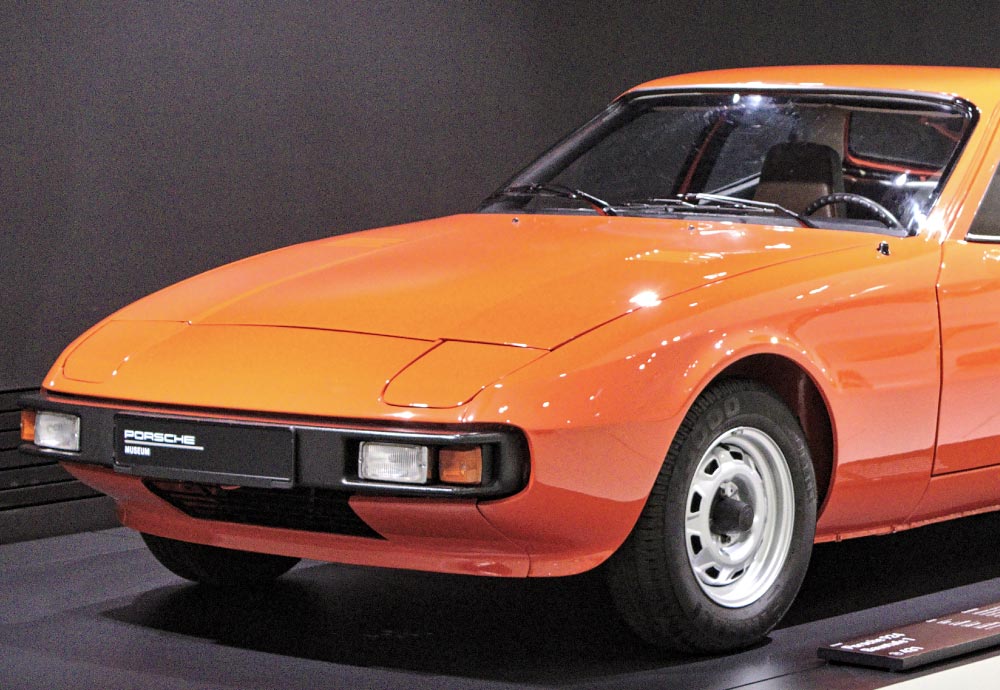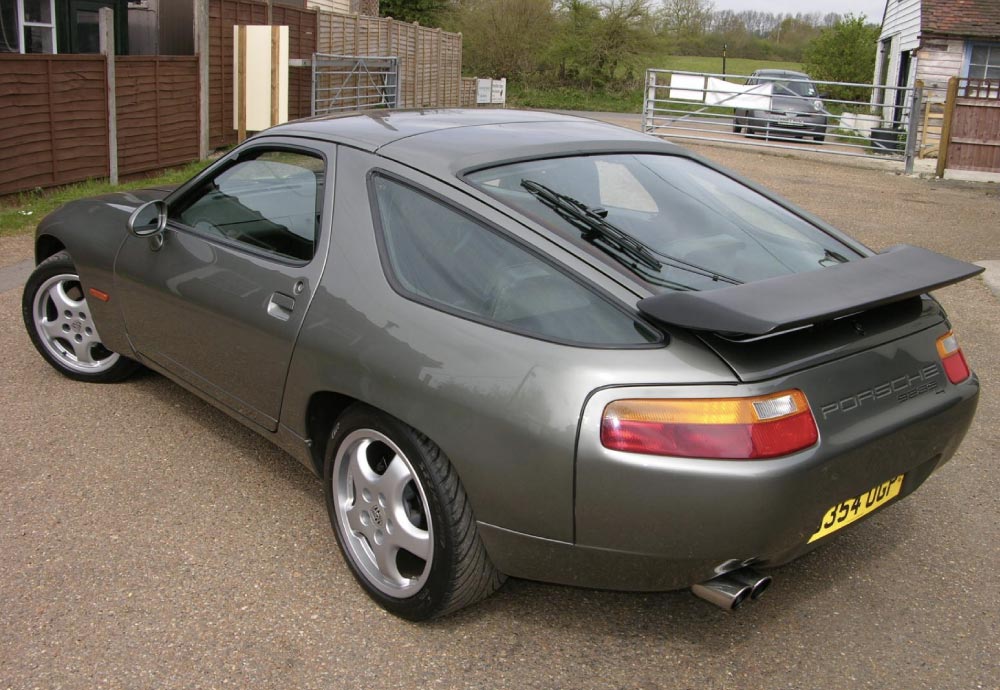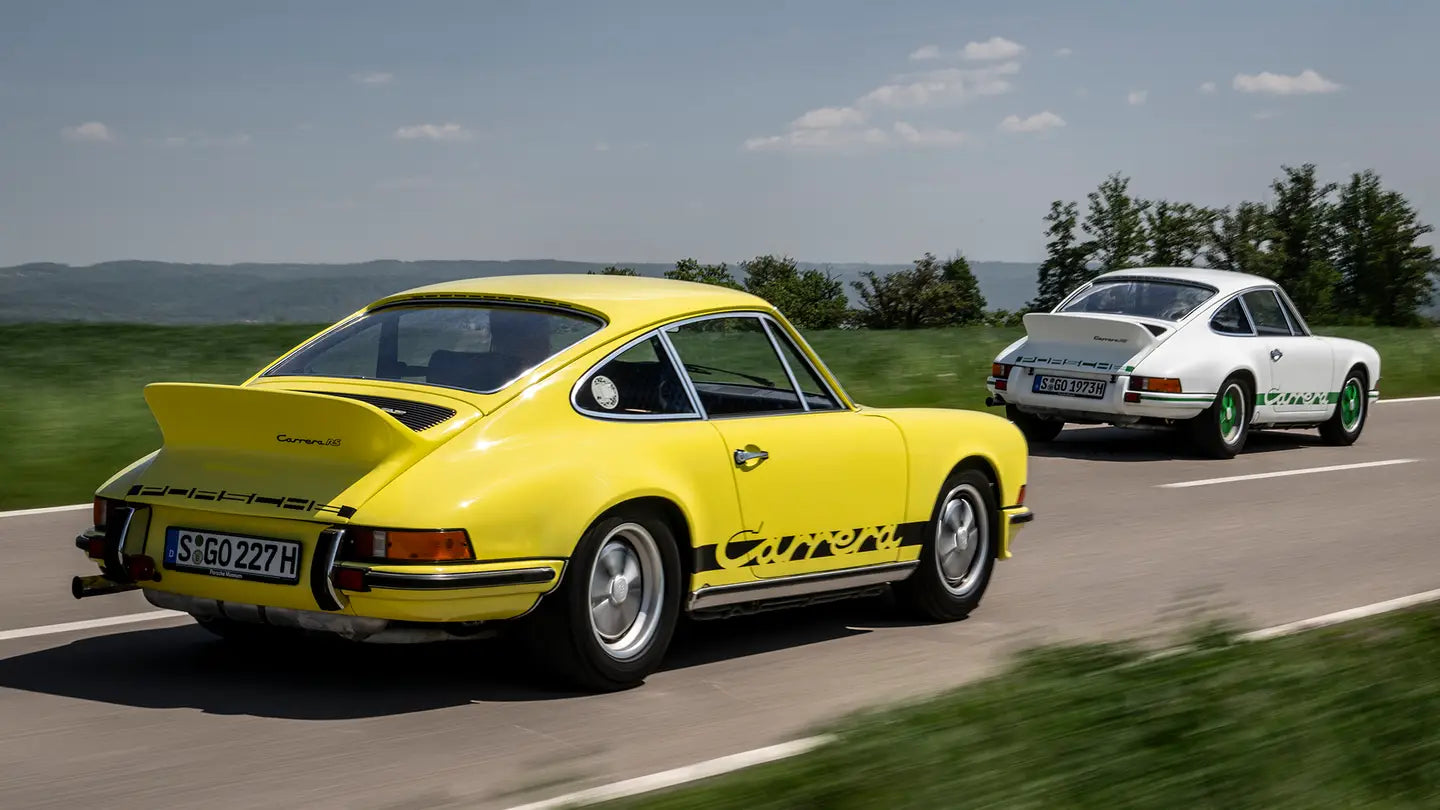The Porsche 924 was produced by Porsche from 1976 to 1988. A two-door, 2+2 coupé, the 924 replaced the 914 as the company's entry-level model, and was the model that finally retired the 912. It was the first Porsche model powered by a water-cooled, front-mounted engine to make production, although the similarly-configured 928 was designed before the 924. The front-engine, rear wheel drive arrangement was normal for most other manufacturers, but it was unusual for Porsche, who had previously only used mid or rear-mounted engines of a boxer configuration, all of which had been air-cooled.
The first official appearance of the 924 took place in November 1975 (as a press launch rather than a motorshow appearance) at the harbour at La Grande Motte, Camargue in the south of France. The model was a success and not only helped to take Porsche out of financial ruin, but created the revenue stream needed to continue building and developing the 911. The 924 was replaced by the 944 in 1982 in the US market, but continued to be produced until 1985 in the Rest of World market.
For the 1986 to 1988 model years the car aqquired the powerplant from the 944 model and became the Porsche 924S.
The first official appearance of the 924 took place in November 1975 (as a press launch rather than a motorshow appearance) at the harbour at La Grande Motte, Camargue in the south of France. The model was a success and not only helped to take Porsche out of financial ruin, but created the revenue stream needed to continue building and developing the 911. The 924 was replaced by the 944 in 1982 in the US market, but continued to be produced until 1985 in the Rest of World market.
For the 1986 to 1988 model years the car aqquired the powerplant from the 944 model and became the Porsche 924S.
924
The 924 was originally intended to be Volkswagen's flagship coupé sports car. Volkswagen commissioned Porsche to design the car (VW project number 425), who developed a fresh chassis and transmission that would work with an existing Audi I4 engine. They also handled the suspension and the interior and exterior design. Porsche decided on a rear wheel drive layout, and chose a rear transaxle to help provide 48/52 front/rear weight distribution. This slight rear weight bias, despite the front mounted engine, aided both traction and brake balance.
Due to growing concern over the 1973 oil crisis and a change of directors at Volkswagen, they put the 425 project on hold, eventually dumping it entirely after their decision to move forward with the Volkswagen Scirocco model instead. Porsche, who needed a model to replace the 914, made a deal with Volkswagen leadership, agreeing to buy the design for an undisclosed figure—some suggest 100 million DM, others say 160 million—but most agree it was less than the amount Volkswagen paid Porsche to design it.
The deal specified that the car would be built at the ex-NSU factory in Neckarsulm located north of the Porsche headquarters in Stuttgart, the Volkswagen employees would do the actual production line work and that Porsche would own the design. It became one of Porsche's best-selling models to date, and the relative cheapness of building the car made it both profitable and fairly easy for Porsche to finance.
The original design used an Audi-sourced four-speed manual transmission for the 924 mated to VW's EA831 2.0 L I4 engine, previously used in the Audi 100 and Volkswagen LT van and producing 95 hp (71 kW) in North American trim. This was brought up to 110hp (87kw) in mid-1977 with the introduction of a catalytic converter, which reduced the need for power-robbing smog equipment. The four-speed manual was the only transmission available for the initial 1976 model. An Audi three speed automatic was offered starting with the 1977.5 model.
European models, which didn't require any emissions equipment, made 125 hp. They also differed visually from the US spec model by not having the US cars low-speed impact bumpers and the round reflectors on each end of the body.
A 5-speed transmission, available starting in 1979, was a "dogleg" Porsche unit, with first gear below reverse on the left side. This was troublesome and was quickly replaced for 1980 with a normal H-pattern Audi five speed. The brakes were solid discs at the front and drums at the rear. The car was criticised in Car and Driver magazine for this braking arrangement, which was viewed as a step backward from the 914's standard four-wheel disc brakes. However, four wheel disc brakes, five stud hubs and alloys from the 924 Turbo were available on the base 924 as an "S" package starting with the 1980 model year.
The overall styling was penned by Dutchman Harm Lagaay, a member of the Porsche styling team, with the hidden headlights, sloping bonnet line and grille-less nose giving the car its popular wedge shape. The car went on sale in the USA in July 1976 as a 1977 model with a base price of $9,395. Porsche made small improvements to the 924 each model year between 1977 and 1985, but nothing major was changed.
Due to growing concern over the 1973 oil crisis and a change of directors at Volkswagen, they put the 425 project on hold, eventually dumping it entirely after their decision to move forward with the Volkswagen Scirocco model instead. Porsche, who needed a model to replace the 914, made a deal with Volkswagen leadership, agreeing to buy the design for an undisclosed figure—some suggest 100 million DM, others say 160 million—but most agree it was less than the amount Volkswagen paid Porsche to design it.
The deal specified that the car would be built at the ex-NSU factory in Neckarsulm located north of the Porsche headquarters in Stuttgart, the Volkswagen employees would do the actual production line work and that Porsche would own the design. It became one of Porsche's best-selling models to date, and the relative cheapness of building the car made it both profitable and fairly easy for Porsche to finance.
The original design used an Audi-sourced four-speed manual transmission for the 924 mated to VW's EA831 2.0 L I4 engine, previously used in the Audi 100 and Volkswagen LT van and producing 95 hp (71 kW) in North American trim. This was brought up to 110hp (87kw) in mid-1977 with the introduction of a catalytic converter, which reduced the need for power-robbing smog equipment. The four-speed manual was the only transmission available for the initial 1976 model. An Audi three speed automatic was offered starting with the 1977.5 model.
European models, which didn't require any emissions equipment, made 125 hp. They also differed visually from the US spec model by not having the US cars low-speed impact bumpers and the round reflectors on each end of the body.
A 5-speed transmission, available starting in 1979, was a "dogleg" Porsche unit, with first gear below reverse on the left side. This was troublesome and was quickly replaced for 1980 with a normal H-pattern Audi five speed. The brakes were solid discs at the front and drums at the rear. The car was criticised in Car and Driver magazine for this braking arrangement, which was viewed as a step backward from the 914's standard four-wheel disc brakes. However, four wheel disc brakes, five stud hubs and alloys from the 924 Turbo were available on the base 924 as an "S" package starting with the 1980 model year.
The overall styling was penned by Dutchman Harm Lagaay, a member of the Porsche styling team, with the hidden headlights, sloping bonnet line and grille-less nose giving the car its popular wedge shape. The car went on sale in the USA in July 1976 as a 1977 model with a base price of $9,395. Porsche made small improvements to the 924 each model year between 1977 and 1985, but nothing major was changed.
924 Turbo
Porsche executives soon recognized the need for a higher-performance version of the 924 that could bridge the gap between the basic 924 and the 911s. Having already found the benefits of turbochargers on several race cars and the 1975 911 Turbo, Porsche chose to use this technology for the 924, eventually introducing the 924 Turbo as a 1978 model.
Porsche started with the same Audi-sourced 2.0 L I4, designed an all new cylinder head (which was hand assembled at Stuttgart), dropped the compression to 7.5:1 and engineered a KKK K-26 turbocharger for it. With 10 psi (70 kPa) boost, output increased to 170 hp (127 kW). The 924 Turbo engine assembly weighed about 65lbs more, so front spring rates and anti-roll bars were revised. Weight distribution was now 49/51 compared to the original 924 figure of 48/52 front to rear.
In order to help make the car more functional, as well as to distinguish it from the naturally-aspirated version, Porsche added a NACA duct in the hood and air intakes in the badge panel in the nose, 15-inch spoke-style alloy wheels, four-wheel disc brakes with 5 stud hubs and a five-speed transmission. Forged 16" flat wheels from the 928 were optional.
Internally, Porsche called it 931 (left hand drive) and 932 (right hand drive), much like the 911 Carrera Turbo, which had been "Type 930". These designations are commonly used by 924 aficionados.
The turbocharged engine allowed the 924's performance to come surprisingly close to that of the 911 SC (180 bhp), thanks in part to a lighter curb weight, but it also brought reliability problems.
Intense heat in the engine bay lead to short turbocharger life and turbo-related seal and seat problems. To fix the problems, Porsche released a revised 924 Turbo series 2 (although badging still read 924 Turbo) in 1981. By using a smaller turbocharger running at increased boost, slightly higher compression of 8:1 and an improved fuel injection system with DITC ignition triggered by the flywheel, reliability improved and power rose to 177 hp (132 kW).
After a successful sales run of both naturally-aspirated and turbo models, in 1981 Porsche decided to surprise everyone and a new 924 variant was unveiled at Le Mans 24 Hours.
By adding an intercooler, increasing compression to 8.5:1 as well as various other little changes, Porsche was able to develop the 924 Turbo into the race car they had wanted, dubbing it the 924 Carrera GT.
Visually it differed to the 931 in that it had polyurethane plastic front and rear flared guards, a polyurethane plastic front spoiler, a top mounted air scoop for the intercooler, a much larger rubber rear spoiler and a flush mounted front windscreen. It lost the 931's NACA duct in the hood but retained the air intakes in the badge panel. This more aggressive styling was later used for as motivation for the 944.
In order to comply with the homologation regulations, the 924 Carrera GT and later 924 Carrera GTS were offered as road cars as well, producing 210 and 245 hp (157 and 183 kW) respectively. Clubsport versions of the GTS were available with a factory included Matter rollcage and race seats. 924 Carrera GT variations were known by model numbers 937 (left hand drive) and 938 (right hand drive).
The ultimate development of the 924 in its race trim was the 924 Carrera GTR race car, which produced 375 hp (280 kW) from a highly modified version of the 2.0 L I4 used in all 924s except for the 944 Carrera GTP which used a highly modified as yet unreleased 944 2.5 litre DOHC 16v Porsche unit. This last model variant came 7th overall at Le Mans 24 Hours and spent the least time out of any other car in the pits.
Production of the 924 Turbo ceased in 1982 except for the Italian market which lasted until 1984. This is due to the restrictions on engines larger than 2 liters, putting the 2.5 liter 944 into a much higher tax category.
Porsche started with the same Audi-sourced 2.0 L I4, designed an all new cylinder head (which was hand assembled at Stuttgart), dropped the compression to 7.5:1 and engineered a KKK K-26 turbocharger for it. With 10 psi (70 kPa) boost, output increased to 170 hp (127 kW). The 924 Turbo engine assembly weighed about 65lbs more, so front spring rates and anti-roll bars were revised. Weight distribution was now 49/51 compared to the original 924 figure of 48/52 front to rear.
In order to help make the car more functional, as well as to distinguish it from the naturally-aspirated version, Porsche added a NACA duct in the hood and air intakes in the badge panel in the nose, 15-inch spoke-style alloy wheels, four-wheel disc brakes with 5 stud hubs and a five-speed transmission. Forged 16" flat wheels from the 928 were optional.
Internally, Porsche called it 931 (left hand drive) and 932 (right hand drive), much like the 911 Carrera Turbo, which had been "Type 930". These designations are commonly used by 924 aficionados.
The turbocharged engine allowed the 924's performance to come surprisingly close to that of the 911 SC (180 bhp), thanks in part to a lighter curb weight, but it also brought reliability problems.
Intense heat in the engine bay lead to short turbocharger life and turbo-related seal and seat problems. To fix the problems, Porsche released a revised 924 Turbo series 2 (although badging still read 924 Turbo) in 1981. By using a smaller turbocharger running at increased boost, slightly higher compression of 8:1 and an improved fuel injection system with DITC ignition triggered by the flywheel, reliability improved and power rose to 177 hp (132 kW).
After a successful sales run of both naturally-aspirated and turbo models, in 1981 Porsche decided to surprise everyone and a new 924 variant was unveiled at Le Mans 24 Hours.
By adding an intercooler, increasing compression to 8.5:1 as well as various other little changes, Porsche was able to develop the 924 Turbo into the race car they had wanted, dubbing it the 924 Carrera GT.
Visually it differed to the 931 in that it had polyurethane plastic front and rear flared guards, a polyurethane plastic front spoiler, a top mounted air scoop for the intercooler, a much larger rubber rear spoiler and a flush mounted front windscreen. It lost the 931's NACA duct in the hood but retained the air intakes in the badge panel. This more aggressive styling was later used for as motivation for the 944.
In order to comply with the homologation regulations, the 924 Carrera GT and later 924 Carrera GTS were offered as road cars as well, producing 210 and 245 hp (157 and 183 kW) respectively. Clubsport versions of the GTS were available with a factory included Matter rollcage and race seats. 924 Carrera GT variations were known by model numbers 937 (left hand drive) and 938 (right hand drive).
The ultimate development of the 924 in its race trim was the 924 Carrera GTR race car, which produced 375 hp (280 kW) from a highly modified version of the 2.0 L I4 used in all 924s except for the 944 Carrera GTP which used a highly modified as yet unreleased 944 2.5 litre DOHC 16v Porsche unit. This last model variant came 7th overall at Le Mans 24 Hours and spent the least time out of any other car in the pits.
Production of the 924 Turbo ceased in 1982 except for the Italian market which lasted until 1984. This is due to the restrictions on engines larger than 2 liters, putting the 2.5 liter 944 into a much higher tax category.
924S
In 1986 the 924S was released. Porsche realised with the 944's prices increasing with new standard features and options, they were losing their place as Porsches entry-level model car. While the 924 had always been available in other markets, Porsche decided to re-introduce the 924 to the American market with an initial price under $20,000. The 924S had an old-spec 944 engine producing 150 bhp and drivetrain but with a normal slim 924 body. It also retained the original 924's spartan, VW-like interior. In 1987 the 924S Le Mans (or Special Edition) was made available in limited numbers with a 944 spec 163hp engine, uprated suspension and cosmetically upgraded interior and exterior. This special 924 had manual windows, no sunroof, and no air conditioning to save weight, although you could order one with air conditioning if you so wished.
In 1988, the final year of production for the 924S, the power for all models was brought up to 163 hp (122 kW). This made the 924S faster than the base 944 due to its lighter weight and more aerodynamic body. Due to unfavorable exchange rates in the late 1980s, Porsche decided to focus on upmarket models. They dropped the 924S for the 1989 model year, and stopped producing the base 944 later that same year
In 1988, the final year of production for the 924S, the power for all models was brought up to 163 hp (122 kW). This made the 924S faster than the base 944 due to its lighter weight and more aerodynamic body. Due to unfavorable exchange rates in the late 1980s, Porsche decided to focus on upmarket models. They dropped the 924S for the 1989 model year, and stopped producing the base 944 later that same year
Did you enjoy this article? Avoid missing future publications by subscribing to this blog's RSS feed using
https://frazerpart.com/blogs/porsche-history.atom
https://frazerpart.com/blogs/porsche-history.atom




